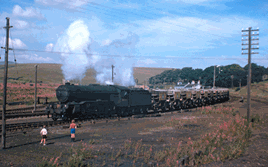Through the dark times of the 1970s and early 1980s, Scotland’s railways seemed to be struggling with a declining network made up of old, worn stock. But by the mid-1980s, attitudes had begun to change. Stations started to be opened (or re-opened), and the reinstating of passenger services along the previously freight-only Edinburgh to Bathgate line in 1986 was an outstanding success - leading to the extension of the line to Glasgow and electrification in 2010.
These station re-openings throughout the country left Midlothian and Scottish Borders Councils as the only two main line regions not to have any stations in their area by 2010. But with the successes of lines such as at Bathgate, supporters such as the Campaign for Borders Rail saw the possibility of re-opening the Waverley Route. They gathered thousands of signatures on a petition pushing for the railway to be re-opened.
The movement gained an important foothold in April 1999, when the Scottish Executive commissioned a Feasibility Study into re-opening the Waverley Line between Edinburgh and Carlisle, following recommendations made in an interim report of the Borders Working Party (set up in August 1998 by then Scottish Office Business and Industry Minster Lord Macdonald).
This study, by consultant Scott Wilson, was published in February 2000 and found that:
ν Much of the trackbed and structures could be re-used, with speeds of 70mph-90mph possible on a single line. But a range of major constraints on the route, such as crossing the A7 Edinburgh City Bypass, would require significant investment to overcome.
ν The route would be more suited to regional-style diesel multiple units than high-speed inter-city services.
ν A half-hour service between Tweedbank and Edinburgh could cover its own direct operating costs.
But critically, the study found against reinstating the whole of the Waverley Route from Edinburgh to Carlisle. It said that would be expensive - over £100m (in 1999 figures) for basic infrastructure - because of the gaps in the infrastructure south of Tweedbank. It also found that train operating companies and Railtrack saw few benefits to such a through route, as it would be relatively slow for passengers and the gradients made it unattractive to through freight.
In September 2003, the Waverley Railway Bill was lodged with the Scottish Parliament, and with it the order to get authorisation to rebuild the railway. By March 2005, the Scottish Executive announced it had provisionally agreed to provide £115m (out of a total cost of £151m) to re-open the line to the Scottish Borders.
Delays (due to a council failing to notify the owners of 130 properties in Gorebridge and Galashiels of the plans, when the Bill was first introduced in 2003) meant it wasn’t until June 2006 that the Scottish Parliament voted 114-1 in favour of the Waverley Railway Bill. It was given Royal Assent and became the Waverley Railway (Scotland) Act 2006, with approval to build the line from Edinburgh to Tweedbank (just south east of Galashiels). The Scottish Parliament now pledged £155m towards the cost, with £11.3m from local councils and £7.4m from developers.
In 2008 Transport Scotland - the national transport agency created in 2006 - took over responsibility for the project, which became known officially as the Borders Railway.















Login to comment
Comments
frank h - 07/01/2016 00:07
I can see it being extended to Hawick but no further, it's about 41 miles to Carlisle from there with Langholm the only major town/village.
Michael - 31/07/2020 20:48
Brilliant article. I hope it all comes into fruition.😊
Anthony Hancock - 21/03/2021 19:20
Agree that the line must be extended to Carlisle. The sooner the better